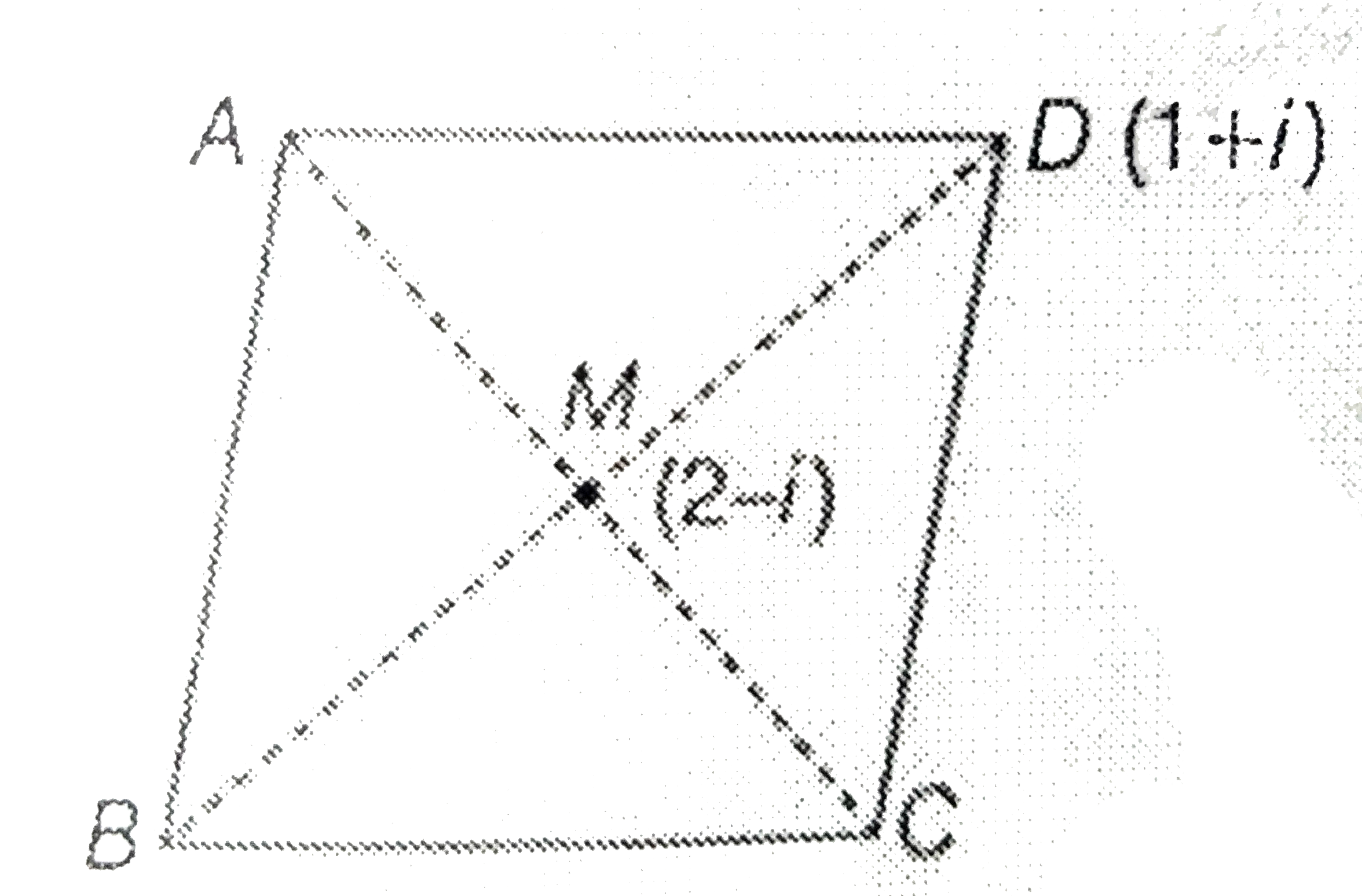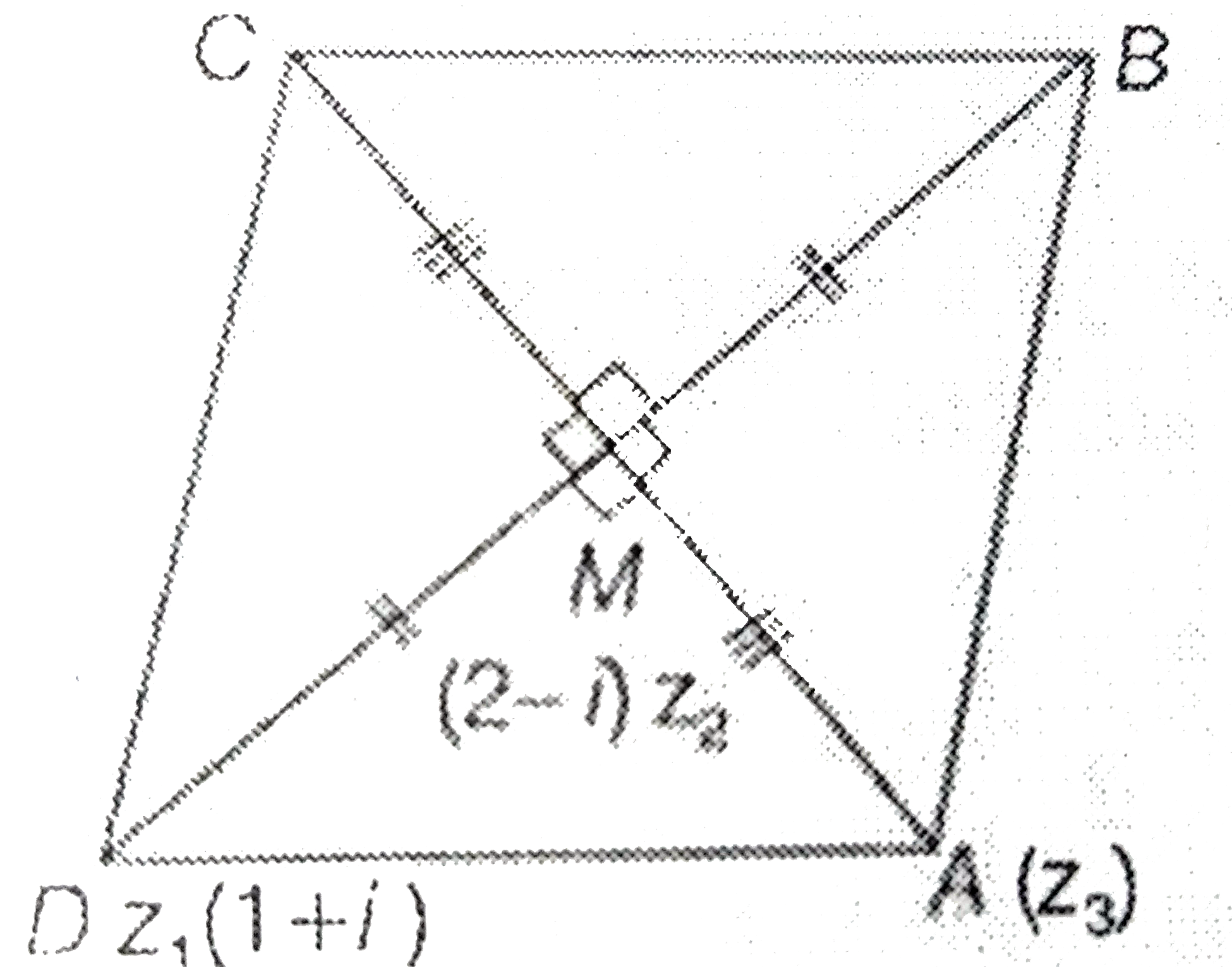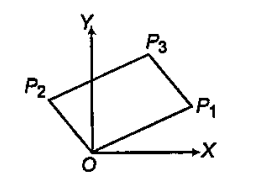ABCD is a rhombus. Its diagonals ACandBD intersect at the point M and satisfy BD=2AC.If he point DandM represent the complex numbers 1+iand2−i respectively, then A represents the complex number......or......
Video Solution
Text Solution
The correct Answer is:3−i2 or 1−3i2
Given D=(1+i),M =(2-i)
and diagonals of a rhombus bisect each other.
Let B≡(a+ib) therefore
a+12=2,b+12−1
⇒a+1=4,b+1=−2⇒a=3,b=−3
a+1=4,b+1=−2⇒a=3,b=−3
⇒B=(3−3i)

Again DM=√(2−1)2+(−1−1)2=√1+4=√5
But BD=2DM⇒BD=2√5
and 2AC=BD⇒2AC=2√5
⇒AC=√5andAC=2AM
⇒√5=2AM⇒AM=√52
Now ,let coordinate of A be (x+ iy)
But in a rhombus AD=AB therefore we have
AD2=AB2
⇒(x−1)2+(y−1)2=(x−3)2+(y+3)2
⇒x2+1−2x+y2+1−2y=x2+9−6x+y2+9+6y
⇒4x−8y=16
x−2y=4
⇒x=2y+4
Again AM=√52⇒AM2=54
⇒(x−2)2+(y+1)2=54 [from Eq. (i)]
⇒5y2+10y+5=54
20y4+40y+15=0
⇒4y2+8y+3=0
⇒(2y+1)(2y+3)=0
2y+1=0,2y+3=0
⇒y=−12,y=−32
on putting these values in Eq.(i) we get
x=2(−12)+4,x=2(−32)+4
⇒x=3,x=1
Therefore A is either (3−i2)or(1−3i2)
Alternate Solution
since, M is the centre of rhombus
∴ By rotating D about M through an angle of ±π/2 we get possible position of A .

⇒z3−(2−i)−1+2i=12(±i)⇒z3−(2−i)−1+2i=12(±i)
⇒z3=(2−i)±12i(2i−1)=(2−1)±12(−2−1)
=4−2i−2−i2,4−2i+2+i2=1−32i,3−i2
∴A is either (1−32i)or(3−i2)
|
Updated on:21/07/2023
Topper's Solved these Questions
- BOOK - IIT JEE PREVIOUS YEARCHAPTER - COMPLEX NUMBERSEXERCISE - TOPIC 4 ROTATION OF A COMPLEX NUMBER (ANALYTICAL & DESCRIPTIVE QUESTIONS)7videos
COMPLEX NUMBERS
- BOOK - IIT JEE PREVIOUS YEARCHAPTER - COMPLEX NUMBERSEXERCISE - TOPIC 4 ROTATION OF A COMPLEX NUMBER (INTERGER ANSWER TYPE QUESTION )1videos
COMPLEX NUMBERS
- BOOK - IIT JEE PREVIOUS YEARCHAPTER - COMPLEX NUMBERSEXERCISE - TOPIC 4 ROTATION OF A COMPLEX NUMBER (OBJECTIVE QUESTION II)(ONE OR MORE THAN ONE CORRECT OPTION)2videos
COMPLEX NUMBERS
- BOOK - IIT JEE PREVIOUS YEARCHAPTER - CIRCLEEXERCISE - Topic 5 Integer Answer type Question1videos
CIRCLE
- BOOK - IIT JEE PREVIOUS YEARCHAPTER - DEFINITE INTEGRATIONEXERCISE - LIMITS AS THE SUM6videos
DEFINITE INTEGRATION
Similar Questions
Knowledge Check
- Question 1 - Select One
In a given parallelogram, if the points P1 and P2 represent two complex numbers z1 and z2, then the point P3 represents the number
 Az1+z2Bz1−z2Cz1×z2Dz1+z2
Az1+z2Bz1−z2Cz1×z2Dz1+z2 - Question 2 - Select One
In a rhombus ABCD the diagonals AC and BD intersect at the point (3,4) . If the point A is (1,2) the diagonal BD has the equation
Ax - y - 1 = 0Bx + y - 1 = 0Cx - y + 1 = 0Dx + y - 7 =0 - Question 3 - Select One
The points represented by the complex numbers 1+i,−2+3i and 53i on the argand diagram are
AVertices of an equilateral triangleBVertices of an isosceles triangleCCollinearDNone of the above
If |z|=2 then the points representing the complex number −1+5z will be
View SolutionABCD is a rhombus whose diagonals intersect at O. If AB=10cm, diagonals BD=16 cm , find the length of diagonal AC
View SolutionThe points A,B and C represent the complex numbers z1,z2,(1−i)z1+iz2 respectively, on the complex plane (where, i=√−1). The △ABC, is
View SolutionIn a rhombus ABCD the diagonals AC and BD intersect at the point (3,4) . If the point A is (1,2) the diagonal BD has the equation
View SolutionThe points represented by the complex numbers 1+i,−2+3i and 53i on the argand diagram are
View Solution

